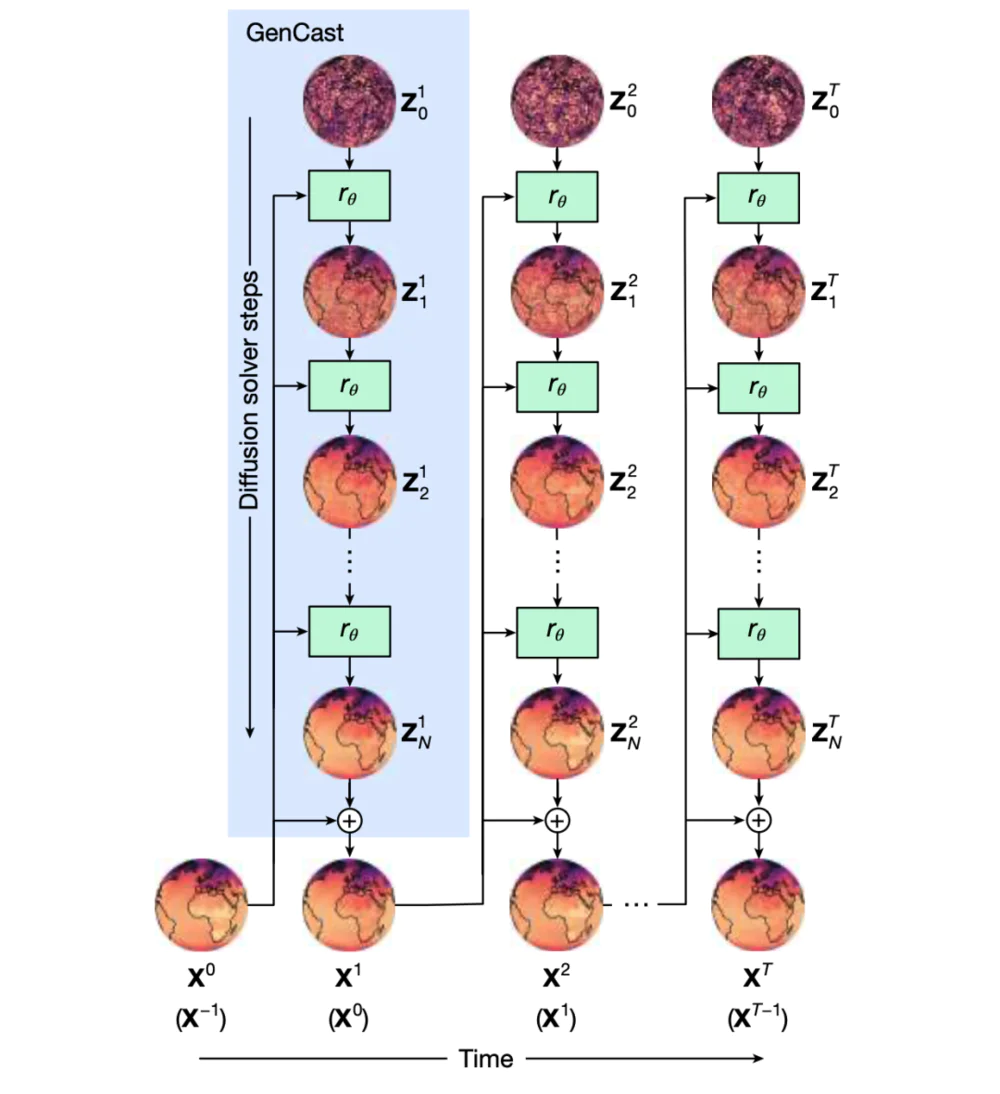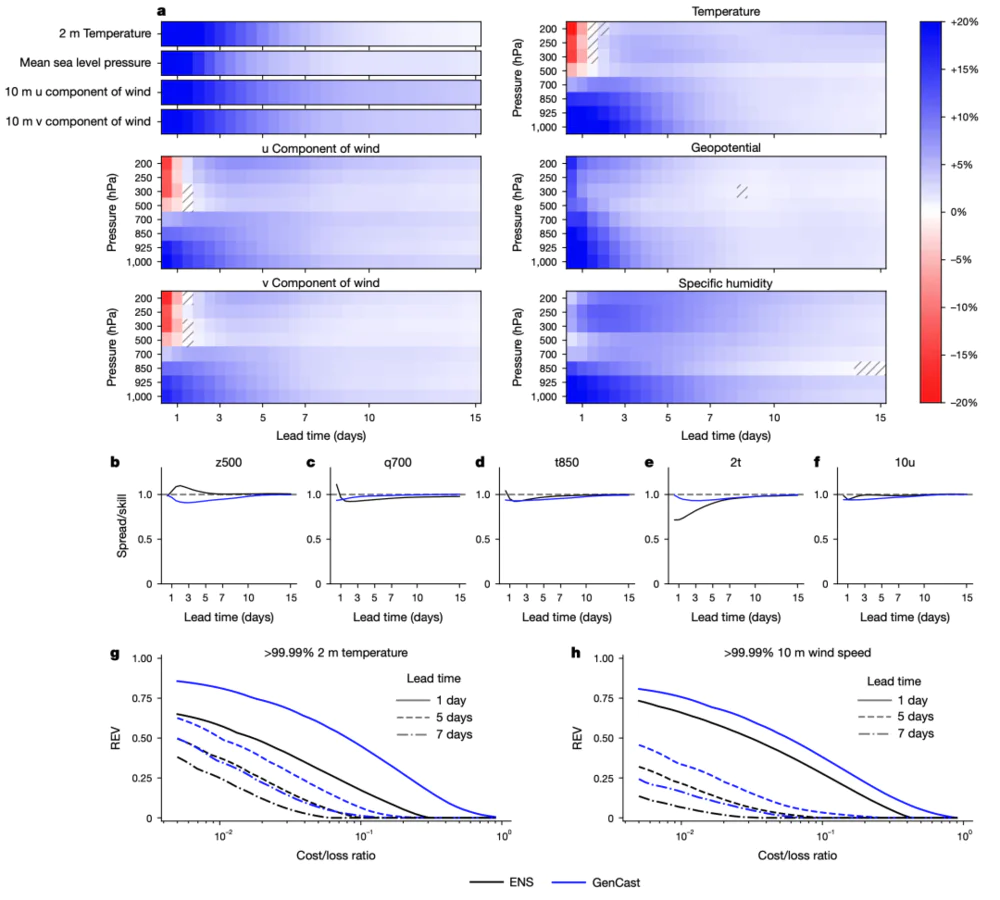Data from the World Meteorological Organization (WMO) shows that, over the past 50 years, an average of one disaster related to weather, climate, or water has occurred every day, causing 115 deaths and economic losses of 202 million USD per day.
Therefore, developing more accurate weather forecasting systems is crucial for saving millions of lives and reducing trillions of dollars in economic losses.
However, traditional weather forecasting relies on numerical weather prediction (NWP) algorithms, which are computationally intensive and time-consuming to build, making it difficult to quickly generate forecast results. Machine learning-based weather forecasting (MLWP) has made breakthroughs in efficiency and single forecast accuracy, but it still struggles with quantifying forecast uncertainty and handling complex spatiotemporal correlations, performing less well than NWP ensemble forecast systems.
Today, GenCast, an AI model developed by the Google DeepMind research team, takes weather forecasting accuracy and efficiency to a whole new level:
GenCast can generate a set of random 15-day global forecasts, with a 12-hour time step and a resolution of 0.25°, covering over 80 surface and atmospheric variables, in just 8 minutes. It outperforms the current best global medium-range forecast— the European Centre for Medium-Range Weather Forecasts (ECMWF) ensemble forecast (ENS) in 97.2% of the evaluation metrics (a total of 1320 metrics), and also provides better marginal and joint forecast distributions.
In addition, GenCast is more effective in forecasting extreme weather (such as heatwaves and strong winds), tropical cyclone paths, and wind energy production.
The related research paper, titled "Probabilistic Weather Forecasting with Machine Learning," has been published in the prestigious scientific journal Nature.

GenCast: Faster and More Accurate Future Weather Forecasts
GenCast is a completely new probabilistic weather forecasting model that generates a series of possible weather scenarios using a conditional diffusion model. Its core capability is modeling the conditional probability distribution of future weather states, which generates forecasts based on the current and past weather conditions. This method allows GenCast to provide 15-day probabilistic weather forecasts globally with higher speed and accuracy.
Specifically, the GenCast architecture includes three main modules: an encoder, a processor, and a decoder. The encoder maps the initial weather state onto a spherical grid that is refined into 6 subdivisions, while the processor captures complex spatiotemporal correlations between grid points using a graph transformer. The decoder then maps the results back to a global latitude-longitude grid to generate the final weather forecast.

Image: Diagram illustrating how GenCast generates weather forecasts.
Additionally, the research team trained GenCast using ERA5 reanalysis data, which includes the best global weather estimates from the past 40 years, ensuring the model's generalization capability and deep understanding of historical weather patterns.
To evaluate GenCast's real-world performance, the research team conducted benchmark tests and compared it with current state-of-the-art systems and models. To ensure a fair comparison, all models were initialized using ERA5 data and unified to a resolution of 0.25°.
In experiments comparing with other systems, the weather samples generated by GenCast were closer to actual observations, with forecast distributions covering a wide range of possible scenarios, providing users with a more comprehensive understanding of potential risks. For example, the forecast for Typhoon Hagibis before it made landfall in Japan was very clear. In the 1-15 day forecast period, its spherical harmonic power spectrum was very close to the ERA5 ground truth.
The research team then evaluated GenCast and ENS in terms of overall forecast skill, calibration, and performance for extreme weather forecasting—specifically marginal forecast performance. Marginal forecasts, which provide specific predictions for the weather conditions at a given time and place, are central to daily weather services.
GenCast showed a strong performance advantage in this area. Its generated forecast distributions more accurately reflected possible weather scenarios, aligning closely with actual data in variables like temperature, wind speed, and pressure, and effectively quantifying forecast uncertainty through improved probabilistic calibration.
Specific studies show that GenCast outperforms ENS in marginal distribution forecasts for multiple meteorological variables. In a test covering 1320 evaluation targets, GenCast achieved higher skill scores (CRPS) in 97.2% of cases, with particularly impressive results for short-term forecasts (1 to 5 days).
At the same time, GenCast also excelled in forecasting extreme weather events like heatwaves and strong winds. Using Brier skill scores and relative economic value (REV) curves to assess model performance, the results show that GenCast significantly outperformed ENS in forecasting high-temperature (99.99% percentile) and extreme low-temperature (0.01% percentile) events.
Moreover, GenCast's marginal distribution forecasts demonstrated excellent calibration, meaning it was able to accurately identify potential errors or biases in its forecasts, providing users with more reliable weather decision-making support.

Image: GenCast’s marginal forecast distribution is skillful and well-calibrated.
In addition to marginal forecasts, GenCast also showed remarkable performance in joint forecasting. Joint forecasting focuses on the spatial and temporal correlations between weather variables, which is crucial for capturing the dynamic characteristics of global weather systems.
For example, in forecasting tropical cyclone tracks, predicting the path of a tropical cyclone depends not only on a single variable but also on multi-layer atmospheric interactions. GenCast can generate weather samples with consistent spatiotemporal correlations, accurately capturing these complex relationships and generating precise forecasts.
The research specifically analyzed GenCast's performance in the case of Typhoon Hagibis. The tropical cyclone track forecast showed that GenCast's uncertainty assessment covered more possible scenarios, and its forecast errors in track location were significantly lower than ENS. More importantly, as the forecast time shortened, GenCast's uncertainty range gradually converged, providing decision-makers with more accurate information on the landing time and location.
Additionally, in regional wind energy forecasting, GenCast transformed 10-meter wind speed data into wind energy output. Its forecast accuracy improved by 20% over ENS, particularly on shorter time scales, offering new possibilities for renewable energy scheduling.

Image: GenCast outperforms ENS in regional wind and tropical cyclone forecasts.
Although GenCast has achieved dual breakthroughs in accuracy and efficiency, there is still room for further optimization. For example, increasing the resolution to match future upgraded ENS systems, or reducing computational costs through distillation techniques. Additionally, fine-tuning with operational data or integrating more traditional NWP initialization methods could significantly enhance its practicality.
How AI Is Reshaping the Future of Climate Forecasting
AI has long been seen as a "faster, cheaper alternative to improving extreme weather forecasts" and has garnered high expectations in the field of weather forecasting. In addition to Google, technology companies and academic institutions such as Huawei and Tsinghua University have made significant strides in this direction.
In July 2023, Huawei Cloud's Pangu-Weather model was published in Nature. It uses 39 years of global reanalysis weather data as training data, achieving forecast accuracy comparable to the world's best numerical weather prediction system, IFS, while being more than 10,000 times faster than IFS at the same spatial resolution (Click to view details).
Another paper published in Nature in the same period introduced NowcastNet, a model developed by a research team led by Michael Jordan from the University of California, Berkeley, and Jianmin Wang from Tsinghua University. This model combines physical laws and deep learning to provide real-time precipitation forecasts. NowcastNet excels in nowcasting, providing high-resolution precipitation forecasts 3 hours in advance for regions as large as 2048 km × 2048 km using radar observation data.
In November 2023, Google DeepMind launched a machine learning-based weather forecasting model, GraphCast, which can forecast hundreds of weather variables for the next 10 days in just one minute at a global 0.25° resolution, significantly outperforming traditional weather forecasting methods and also performing well in forecasting extreme events. The related research paper was published in the prestigious scientific journal Science (Click to view details).
In March 2024, the Google Research flood forecasting team developed an AI model that uses 5,680 sensor measurements to forecast daily runoff for ungauged basins within 7 days. This model outperformed the leading global flood early warning system, GloFAS, in both same-day forecasts and extreme weather events occurring once every five years. The related research paper was published in the authoritative journal Nature (Click to view details).
In July 2024, the Google Research team and collaborators launched a weather forecasting and climate simulation model, NeuralGCM. The model's accuracy in 1-15 day short-term weather forecasts is comparable to the ECMWF model, and it outperforms existing models in cyclone forecasting and trajectory simulations. When sea surface temperature data is added, its 40-year climate forecasts align closely with global warming trends. Additionally, NeuralGCM can generate a 22.8-day atmospheric simulation in just 30 seconds. The related research paper was published in the prestigious journal Nature (Click to view details).
It is believed that in the near future, AI-driven weather forecasting will play an even greater role in disaster warning, energy planning, and climate adaptation, providing stronger tools for humanity to tackle increasingly complex climate challenges.
Link to the paper: https://www.nature.com/articles/s41586-024-08252-9







